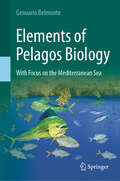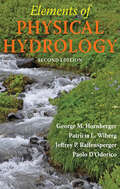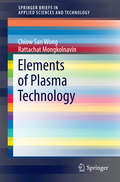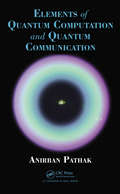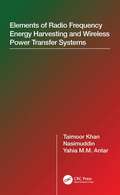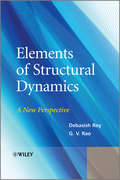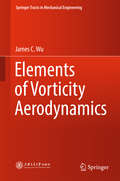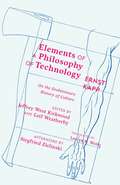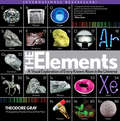- Table View
- List View
Elements of Pelagos Biology: With Focus on the Mediterranean Sea
by Genuario BelmonteOceans cover more than 70% of the Earth's surface, with an average depth of approximately 3,800 meters. Humanity is largely excluded from this vast world of saltwater, which remains mostly unexplored and unknown. The goal of this book is to introduce readers to this unfamiliar and mysterious realm. It delves into various species and communities in great detail, emphasizing that the taxonomy, life cycles, and ecological dynamics differ significantly from what is typically taught in basic Biology and Natural Sciences courses, which often focus on terrestrial or freshwater environments, and occasionally, benthic habitats. The pelagic lifestyle, by contrast, is rarely emphasized in Marine Biology textbooks. This book aims to shift that perspective, highlighting the pelagic way of life for marine organisms. As a teaching method, species, geographical locations, and key topics are repeatedly revisited throughout the text to enhance their visibility and reinforce their understanding in the minds of students.
Elements of Physical Hydrology
by George M. Hornberger Patricia L. Wiberg Jeffrey P. Raffensperger Paolo D'OdoricoThe most cogent textbook ever produced on the topic, this revised and expanded edition will be welcomed by students and professionals alike.Among the many diverse aspects of environmental science, none is more critical to the future of society and nature than water. Understanding the role of water on Earth and making good decisions regarding water conservation and hydrological hazards depends on learning the fundamentals of physical hydrology. This textbook, now in an expanded second edition, provides the clearest opportunity for students to absorb those fundamentals. Written at an introductory level, Elements of Physical Hydrology covers virtually every aspect of this subject, including:• The hydrological cycle• Water budgets at catchment to global scales • Spatial and temporal aspects of precipitation• Evapotranspiration• Fluid dynamics and the Bernoulli equation• Laminar and turbulent flows• Open channel flow • Flood movement through reservoirs and channels • Flood frequency analysis• Groundwater flow• Aquifer characterization• Land subsidence• Soil moisture dynamics• Flow in the unsaturated zone• Hydrologic controls on vegetation • Biotic controls on hydrological processes• Runoff generation from surface and subsurface sources• Catchment models• The water-food-energy nexus• The globalization of water• Impacts of changing climateLayering one topic upon the next, Elements of Physical Hydrology succeeds in moving from simple, easy-to-grasp explanations through equations and models in a manner that will leave students new to the topic eager to apply their knowledge. Professionals in related disciplines will also find this book ideal for self-study. Thoughtfully illustrated, carefully written, and covering a broad spectrum of topics, this classic text clarifies a subject that is often misunderstood and oversimplified.
Elements of Plasma Technology
by Chiow San Wong Rattachat MongkolnavinThis book presents some fundamental aspects of plasma technologythat are important for beginners interested to start research in the area ofplasma technology. These include the properties of plasma, methods of plasmageneration and basic plasma diagnostic techniques. It also discusses severallow cost plasma devices, including pulsed plasma sources such as plasma focus,pulsed capillary discharge, vacuum spark and exploding wire; as well as lowtemperature plasmas such as glow discharge and dielectric barrier dischargewhich the authors believe may have potential applications in industry. Thetreatments are experimental rather than theoretical, although some theoreticalbackground is provided where appropriate. The principles of operation of thesedevices are also reviewed and discussed.
Elements of Quantum Computation and Quantum Communication
by Anirban PathakWhile there are many available textbooks on quantum information theory, most are either too technical for beginners or not complete enough. Filling the gap, this book gives a clear, self-contained introduction to quantum computation and communication. Exploring recent developments and open questions in the field, it prepares readers for further study and helps them understand more advanced texts and journal papers. Along with thought-provoking cartoons and brief biographies of key players in the field, each chapter includes examples, references, exercises, and problems with detailed solutions.
Elements of Radio Frequency Energy Harvesting and Wireless Power Transfer Systems
by Yahia M.M. Antar Taimoor Khan NasimuddinThis book focuses on elementary concepts of both radio frequency energy harvesting (RFEH) and wireless power transfer (WPT), and highlights their fundamental requirements followed by recent advancements. It provides a systematic overview of the key components required for RFEH and WPT applications and also comprehensively introduces the pioneering research advancements achieved to date. The state-of-the-art circuit design topologies for the two different applications are presented mainly in terms of antenna operating frequencies, polarization characteristics, efficient matching network circuits, rectifier topologies, and overall rectenna systems. The book serves as a single point of reference for practicing engineers and researchers searching for potential sources and elements involved in the RFEH system as well as in the WPT system, and need rapid training and design guidelines in the following areas: • Different sensing elements used in RFEH and WPT • Inclusions of mathematical expressions and design problems • Illustration of some design examples and performance enhancement techniques
Elements of Slow-Neutron Scattering
by Carpenter J. M. Loong C. K.Providing a comprehensive and up-to-date introduction to the theory and applications of slow-neutron scattering, this detailed book equips readers with the fundamental principles of neutron studies, including the background and evolving development of neutron sources, facility design, neutron scattering instrumentation and techniques, and applications in materials phenomena. Drawing on the authors' extensive experience in this field, this text explores the implications of slow-neutron research in greater depth and breadth than ever before in an accessible yet rigorous manner suitable for both students and researchers in the fields of physics, biology, and materials engineering. Through pedagogical examples and in-depth discussion, readers will be able to grasp the full scope of the field of neutron scattering, from theoretical background through to practical, scientific applications.
Elements of Statistical Thermodynamics: Second Edition (Dover Books on Chemistry)
by Leonard K. NashThis concise, elementary treatment illustrates the ways in which an atomic-molecular perspective yields new insights and powers operative in the realms of macroscopic thermodynamics. Starting with an analysis of some very simple microcanonical ensembles, it proceeds to the Boltzmann distribution law and a systematic exploration of the proper formulation, evaluation, and application of partition functions. The concepts of equilibrium and entropy thus acquire new significance, and readers discover how thermodynamic parameters may be calculated from spectroscopic data.Encompassing virtually all of the forms of statistical mechanics customary to undergraduate physical chemistry books, this brief text requires prior acquaintance with only the rudiments of the calculus and a few of the simplest propositions of classical thermodynamics. Appropriate for introductory college chemistry courses, it further lends itself to use as a supplementary text for independent study by more advanced students.
Elements of Structural Dynamics: A New Perspective
by Debasish Roy G. V. RaoStructural dynamics is a subset of structural analysis which covers the behavior of structures subjected to dynamic loading. The subject has seen rapid growth and also change in how the basic concepts can be interpreted. For instance, the classical notions of discretizing the operator of a dynamic structural model have given way to a set-theoretic, function-space based framework, which is more conducive to implementation with a computer. This modern perspective, as adopted in this book, is also helpful in putting together the various tools and ideas in a more integrated style. Elements of Structural Dynamics: A New Perspective is devoted to covering the basic concepts in linear structural dynamics, whilst emphasizing their mathematical moorings and the associated computational aspects that make their implementation in software possible. Key features: Employs a novel ‘top down’ approach to structural dynamics. Contains an insightful treatment of the computational aspects, including the finite element method, that translate into numerical solutions of the dynamic equations of motion. Consistently touches upon the modern mathematical basis for the theories and approximations involved. Elements of Structural Dynamics: A New Perspective is a holistic treatise on structural dynamics and is an ideal textbook for senior undergraduate and graduate students in Mechanical, Aerospace and Civil engineering departments. This book also forms a useful reference for researchers and engineers in industry.
Elements of Surprise: Our Mental Limits and the Satisfactions of Plot
by Vera TobinWhy do some surprises delight—the endings of Agatha Christie novels, films like The Sixth Sense, the flash awareness that Pip’s benefactor is not (and never was!) Miss Havisham? Writing at the intersection of cognitive science and narrative pleasure, Vera Tobin explains how our brains conspire with stories to produce those revelatory plots that define a “well-made surprise.” By tracing the prevalence of surprise endings in both literary fiction and popular literature and showing how they exploit our mental limits, Tobin upends two common beliefs. The first is cognitive science’s tendency to consider biases a form of moral weakness and failure. The second is certain critics’ presumption that surprise endings are mere shallow gimmicks. The latter is simply not true, and the former tells at best half the story. Tobin shows that building a good plot twist is a complex art that reflects a sophisticated understanding of the human mind. Reading classic, popular, and obscure literature alongside the latest research in cognitive science, Tobin argues that a good surprise works by taking advantage of our mental limits. Elements of Surprise describes how cognitive biases, mental shortcuts, and quirks of memory conspire with stories to produce wondrous illusions, and also provides a sophisticated how-to guide for writers. In Tobin’s hands, the interactions of plot and cognition reveal the interdependencies of surprise, sympathy, and sense-making. The result is a new appreciation of the pleasures of being had.
Elements of Vorticity Aerodynamics
by James C. WuThe book opens with a discussion of the vorticity-dynamic formulation of the low Mach number viscous flow problem. Physical aspects of the velocity and the vorticity fields, their instantaneous relationship, and the transport of vorticity in viscous fluids are examined for steady and unsteady flows. Subsequently, the mathematical aspects of vorticity dynamics and issues of initial and boundary conditions for the viscous flow problem are treated rigorously using classical analyses. Coverage includes evolution of the vorticity field which surrounds and trails behind airfoils and wings, generalizations of Helmholtz' vortex theorems and the Biot-Savart Law. A theorem is introduced that relates the aerodynamic force to the vorticity moment and the applications of the theorem are reviewed. Interpretations of the Kutta-Joukowski theorem and Prandtl's lifting line theory for vorticity dynamics are presented and wake integral methods are reviewed. The virtual-mass effect is shown to be the seminal event in unsteady aerodynamics and a simple approach for evaluating virtual-mass forces on the basis of vorticity dynamics is presented. The book presents a modern viewpoint on vorticity dynamics as the framework for understanding and establishing the fundamental principles of viscous and unsteady aerodynamics. It is intended for graduate-level students of classical aerodynamics and researchers exploring the frontiers of fully unsteady and non-streamlined aerodynamics.
Elements of a Philosophy of Technology: On the Evolutionary History of Culture (Posthumanities #99)
by Ernst KappThe first philosophy of technology, constructing humans as technological and technology as an underpinning of all culture Ernst Kapp was a foundational scholar in the fields of media theory and philosophy of technology. His 1877 Elements of a Philosophy of Technology is a visionary study of the human body and its relationship with the world that surrounds it. At the book&’s core is the concept of &“organ projection&”: the notion that humans use technology in an effort to project their organs to the outside, to be understood as &“the soul apparently stepping out of the body in the form of a sending-out of mental qualities&” into the world of artifacts.Kapp applies this theory of organ projection to various areas of the material world—the axe externalizes the arm, the lens the eye, the telegraphic system the neural network. From the first tools to acoustic instruments, from architecture to the steam engine and the mechanic routes of the railway, Kapp&’s analysis shifts from &“simple&” tools to more complex network technologies to examine the projection of relations. What emerges from Kapp&’s prophetic work is nothing less than the emergence of early elements of a cybernetic paradigm.
Elements of a Science Plan for the North Pacific Research Board
by Committee on a Science Plan for the North Pacific Research BoardThe North Pacific Research Board (NPRB) was established in 1997 as custodian to a pool of funds intended for the study of the North Pacific Ocean, Bering Sea, and Arctic Ocean. The success of the NRPB is the development of a high quality, long-range science plan that provides a better understanding of ecosystems and their fisheries in the region. This report provides a framework to help the NPRB identify appropriate science themes and mechanisms for administering and distributing the funds. It contains extensive input from residents of Alaskan communities, to help scientists understand and address issues of importance to the local communities. The book makes specific recommendations on long-term research priorities, the NPRB management structure and the development of future programs.
Elements: A Visual Exploration of Every Known Atom in the Universe
by Theodore Gray Nick MannThe Elements has become an international sensation, with over one million copies in-print worldwide. The highly-anticipated paperback edition of The Elements is finally available.An eye-opening, original collection of gorgeous, never-before-seen photographic representations of the 118 elements in the periodic table. The elements are what we, and everything around us, are made of. But how many elements has anyone actually seen in pure, uncombined form? The Elements provides this rare opportunity. Based on seven years of research and photography, the pictures in this book make up the most complete, and visually arresting, representation available to the naked eye of every atom in the universe. Organized in order of appearance on the periodic table, each element is represented by a spread that includes a stunning, full-page, full-color photograph that most closely represents it in its purest form. For example, at -183°C, oxygen turns from a colorless gas to a beautiful pale blue liquid. Also included are fascinating facts, figures, and stories of the elements as well as data on the properties of each, including atomic weight, density, melting and boiling point, valence, electronegativity, and the year and location in which it was discovered. Several additional photographs show each element in slightly altered forms or as used in various practical ways. The element's position on the periodic table is pinpointed on a mini rendering of the table and an illustrated scale of the element's boiling and/or melting points appears on each page along with a density scale that runs along the bottom. Packed with interesting information, this combination of solid science and stunning artistic photographs is the perfect gift book for every sentient creature in the universe.Includes a tear-out poster of Theodore Gray's iconic Photographic Periodic Table!
Elephant Cows: Heads of the Herd (Queens of the Animal Universe)
by Maivboon SangA lion sneaks slowly toward a herd of elephants. The herd’s female leader sees the big cat. Her loud trumpet sound rings out. She charges the lion and it runs away. Females are the leaders of an elephant herd. They protect the herd, lead it to food sources, and care for young. Take a look at elephants and the important roles cows play to ensure the herd’s survival.
Elephant Don: The Politics of a Pachyderm Posse
by Caitlin O'ConnellMeet Greg. He's a stocky guy with an outsized swagger. He's been the intimidating yet sociable don of his posse of friends--including Abe, Keith, Mike, Kevin, Torn Trunk, and Willie. But one arid summer the tide begins to shift and the third-ranking Kevin starts to get ambitious, seeking a higher position within this social club. But this is no ordinary tale of gangland betrayal--Greg and his entourage are bull elephants in Etosha National Park, Namibia, where, for the last twenty-three years, Caitlin O'Connell has been a keen observer of their complicated friendships. In Elephant Don, O'Connell, one of the leading experts on elephant communication and social behavior, offers a rare inside look at the social world of African male elephants. Elephant Don tracks Greg and his group of bulls as O'Connell tries to understand the vicissitudes of male friendship, power struggles, and play. A frequently heart-wrenching portrayal of commitment, loyalty, and affection between individuals yearning for companionship, it vividly captures an incredible repertoire of elephant behavior and communication. Greg, O'Connell shows, is sometimes a tyrant and other times a benevolent dictator as he attempts to hold onto his position at the top. Though Elephant Don is Greg's story, it is also the story of O'Connell and the challenges and triumphs of field research in environs more hospitable to lions and snakes than scientists. Readers will be drawn into dramatic tales of an elephant society at once exotic and surprisingly familiar, as O'Connell's decades of close research reveal extraordinary discoveries about a male society not wholly unlike our own. Surely we've all known a Greg or two, and through this book we may come to know them in a whole new light.
Elephant House (Animalibus)
by Nigel RothfelsIn Elephant House, photographer Dick Blau and historian Nigel Rothfels offer a thought-provoking study of the Oregon Zoo’s Asian Elephant Building and the daily routines of its residents—human and pachyderm alike. Without an agenda beyond a desire to build a deeper understanding of this enigmatic environment, Elephant House is the result of the authors’ unique creative collaboration and explores the relationships between captive elephants and their human caregivers.Blau’s evocative photographs are complex and challenging, while Rothfels’s text offers a scholarly and personal response to the questions that surround elephants and captivity. Elephant House does not take sides in the debate over zoos but focuses instead on the bonds of attentiveness between the animals and their keepers. Accompanied by a foreword from retired elephant keeper Mike Keele, Elephant House is a frank, fascinating look at the evolving world of elephant husbandry.
Elephant House (Animalibus: Of Animals and Cultures #7)
by Dick Blau Nigel RothfelsIn Elephant House, photographer Dick Blau and historian Nigel Rothfels offer a thought-provoking study of the Oregon Zoo’s Asian Elephant Building and the daily routines of its residents—human and pachyderm alike. Without an agenda beyond a desire to build a deeper understanding of this enigmatic environment, Elephant House is the result of the authors’ unique creative collaboration and explores the relationships between captive elephants and their human caregivers.Blau’s evocative photographs are complex and challenging, while Rothfels’s text offers a scholarly and personal response to the questions that surround elephants and captivity. Elephant House does not take sides in the debate over zoos but focuses instead on the bonds of attentiveness between the animals and their keepers. Accompanied by a foreword from retired elephant keeper Mike Keele, Elephant House is a frank, fascinating look at the evolving world of elephant husbandry.
Elephant Seals: Population Ecology, Behavior, and Physiology
by Burney J. Le Boeuf Richard M. LawsThe largest of all seals, elephant seals rank among the most impressive of marine mammals. They are renowned for their spectacular recovery from near-extinction at the end of the nineteenth century when seal hunters nearly eliminated the entire northern species. No other vertebrate has come so close to extinction and made such a complete recovery. The physiological extremes that elephant seals can tolerate are also remarkable: females fast for a month while lactating, and the largest breeding males fast for over one hundred days during the breeding seasons, at which times both sexes lose forty percent of their body weight. Elephant seals dive constantly during their long foraging migrations, spending more time under water than most whales and diving deeper and longer than any other marine mammal. This first book-length discussion of elephant seals brings together worldwide expertise from scientists who describe and debate recent research, including the history and status of various populations, their life-history tactics, and other findings obtained with the help of modern microcomputer diving instruments attached to free-ranging seals. Essential for all marine mammalogists for its information and its methodological innovations, Elephant Seals will also illuminate current debates about species extinctions and possible means of preventing them. This title is part of UC Press's Voices Revived program, which commemorates University of California Press’s mission to seek out and cultivate the brightest minds and give them voice, reach, and impact. Drawing on a backlist dating to 1893, Voices Revived makes high-quality, peer-reviewed scholarship accessible once again using print-on-demand technology. This title was originally published in 1994.
Elephant Seals: Pushing the Limits on Land and at Sea
by Bernard J. Le BoeufHow did the elephant seal survive being driven to the brink of extinction in the nineteenth century? What variables determine the lifetime reproductive success of individual seals? How have elephant seals adapted to tolerate remarkable physiological extremes of nutrition, temperature, asphyxia, and pressure? Answering these questions and many more, this book is the result of the author's 50-year study of elephant seals. The chapters cover a broad range of topics including diving, feeding, migration and reproductive behavior, yielding fundamental information on general biological principles, the operation of natural selection, the evolution of social behavior, the formation of vocal dialects, colony development, and population changes over time. The book will be a valuable resource for graduate students and researchers of marine mammal behavior and reproductive life history as well as for amateur naturalists interested in these fascinating animals.
Elephant Slaves and Pampered Parrots: Exotic Animals in Eighteenth-Century Paris (Animals, History, Culture)
by Louise E. RobbinsIn 1775, a visitor to Laurent Spinacuta's Grande Ménagerie at the annual winter fair in Paris would have seen two tigers, several kinds of monkeys, an armadillo, an ocelot, and a condor—in all, forty-two live animals. In Elephant Slaves and Pampered Parrots, Louise Robbins explains that exotic animals from around the world were common in eighteenth-century Paris. In the streets of the city, residents and visitors could observe performing elephants and a fighting polar bear. Those looking for unusual pets could purchase parrots, flying squirrels, and capuchin monkeys. The royal menagerie at Versailles displayed lions, cranes, an elephant, a rhinoceros, and a zebra, which in 1760 became a major court attraction.For Enlightenment-era Parisians, exotic animals both piqued scientific curiosity and conveyed social status. Their availability was a boon for naturalists like Buffon, author of the best-selling Histoire naturelle, who observed unusual species in a variety of locations around the city. Louis XVI saw his menagerie as a manifestation of his power and funded its upkeep accordingly, while critics used the caged animals as metaphors of slavery and political oppression amidst the growing political turmoil. In her engaging and often surprising account, Robbins considers nearly every aspect of France's obsession with exotic fauna, from the vast literature on exotic animals and the inner workings of the oiseleurs' (birdsellers') guild to how the animals were transported, housed, and cared for. Based on wide-ranging and imaginative research, Elephant Slaves and Pampered Parrots stands as a major contribution to the history of human-animal relations, eighteenth-century culture, and French colonialism.
Elephant Tourism in Nepal: Historical Perspectives, Current Health and Welfare Challenges, and Future Directions
by Dr Michelle SzydlowskiA study of elephant tourism in Nepal from its origins in the 1960s to the present day, this book examines the challenges faced by captive elephants. Used as human conveyance, on anti-poaching patrol teams, as rescue vehicles, and in forestry service, elephants have worked with and for humans for hundreds of years. However, the use of elephants in tourism is a fairly new development within Nepal. Because the health and welfare of tourism elephants is vital to the conservation of wild individuals, this book offers an assessment of captive elephant needs and an examination of their existing welfare statuses. Numerous NGOS and INGOs are now active in elephant lives, and numerous advocacy organizations have arisen with the goal of changing tourism practices and improving captive elephant welfare. This book seeks to examine the motivations of these NGOs and INGOs, and to consider their ethical approaches to elephant health and welfare. Are the motivations of these organizations similar enough to work together towards a common goal, or are their ethical norms so different that they get in one another's way? Using an ordinary language and ethics framework, this text aims to identify the norms of cultures and organisations and reframe them in ways which may allow for more successful interactions.
Elephant Trails: A History of Animals and Cultures (Animals, History, Culture)
by Nigel RothfelsWhy have elephants—and our preconceptions about them—been central to so much of human thought?From prehistoric cave drawings in Europe and ancient rock art in Africa and India to burning pyres of confiscated tusks, our thoughts about elephants tell a story of human history. In Elephant Trails, Nigel Rothfels argues that, over millennia, we have made elephants into both monsters and miracles as ways to understand them but also as ways to understand ourselves.Drawing on a broad range of sources, including municipal documents, zoo records, museum collections, and encounters with people who have lived with elephants, Rothfels seeks out the origins of our contemporary ideas about an animal that has been central to so much of human thought. He explains how notions that have been associated with elephants for centuries—that they are exceptionally wise, deeply emotional, and have a special understanding of death; that they never forget, are beloved of the gods, and suffer unusually in captivity; and even that they are afraid of mice—all tell part of the story of these amazing beings. Exploring the history of a skull in a museum, a photograph of an elephant walking through the American South in the early twentieth century, the debate about the quality of life of a famous elephant in a zoo, and the accounts of elephant hunters, Rothfels demonstrates that elephants are not what we think they are—and they never have been. Elephant Trails is a compelling portrait of what the author terms "our elephant."
Elephant management: A Scientific Assessment for South Africa
by R J Scholes & K G MennellElephants are among the most magnificent – but also most problematic –members of South Africa's wildlife population. While they are sought after by South African and foreign tourists alike, they also have a major impact on their environment. As a result, elephant management has become a highly complex and often controversial discipline. The information needed to underpin vital decisions about elephant management has largely been unavailable to decision-makers, contested by experts, or simply unknown. As a result, the South African Minister for Environmental Affairs and Tourism convened a round table to advise him on this issue. The round table recommended that a scientific assessment of elephant management be undertaken to gather, evaluate, and present all the relevant information on this topic. Its main findings and recommendations are contained in this volume. Elephant Management is the first book of its kind, combining the work of more than 60 national and international experts. Extensively reviewed by policy-makers and other stakeholders, it is the most systematic and comprehensive review of savanna elephant populations and factors relevant to managing them to date. As such it is of interest to a broad spectrum of readers in South Africa and elsewhere. Above all, it is aimed at helping conservation policy-makers and practitioners to choose the best possible options for the sustainable preservation of these iconic animals.
Elephants (Readers)
by Avery HurtStomp around the African savanna, run around the forests of India, take a mud bath, and more as you learn all about elephants! Adult and child readers can learn together in this new Level 1 co-reader from National Geographic Kids, full of engaging photos and fun facts.
Elephants (WorldLife Library)
by Joyce PooleBiologist and conservationist Joyce Poole has spent over half her life studying and protecting elephants. In this fascinating introduction to the world's largest land mammal, she teaches you about the elephant's intricate society and strong sense of family, its complex infrasonic communication, its feeding and mating habits, and its chances for survival in a rapidly changing world.
